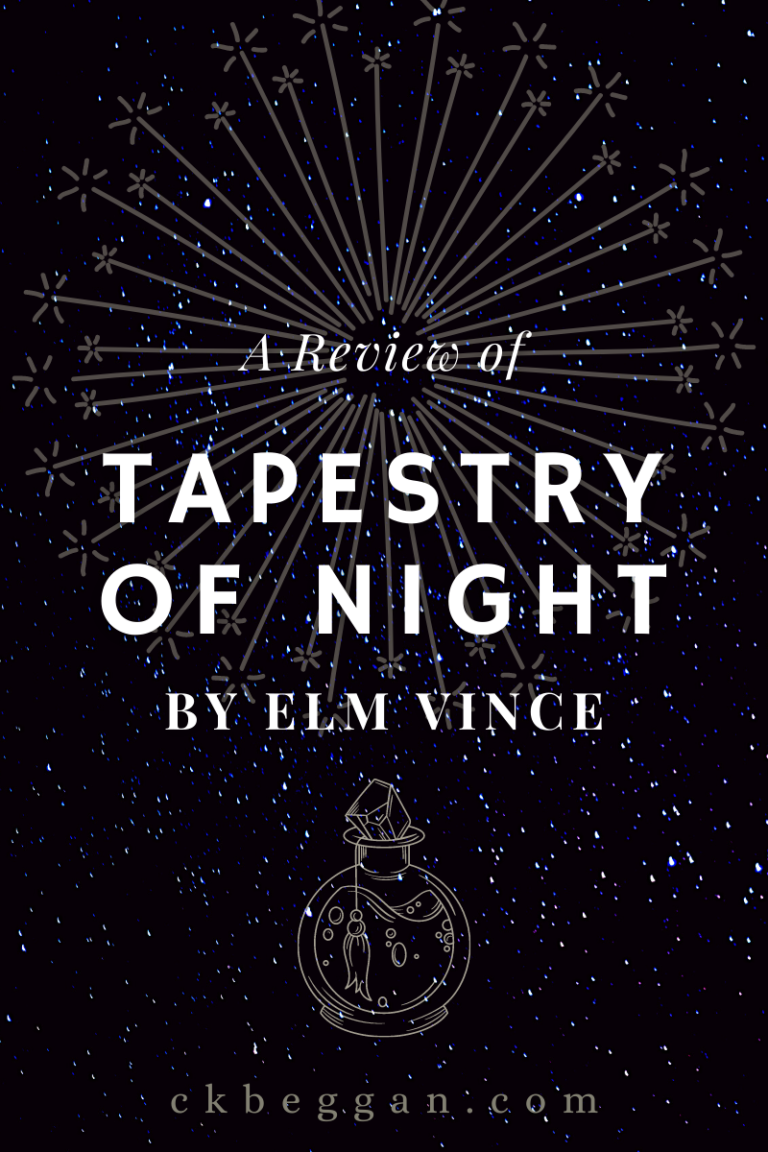In a world where only one late-bloomer can save her people from a terrible fate, the time has come…for another Indie Book Spotlight!

The opening chapter of Elm Vince’s Tapestry of Night shows us that fate can be written in the stars—if those stars are charted properly. Thanks to the Stellar Sisters of Celestial Devotion, Cassia is an expert of making natal star charts, and she has an “uncanny intuition” to go with it.
Eventually, Cassia entrusts the reader with the exciting secret that she has the most unusual—and difficult to understand—prophesied fate of anyone. For a magically late-bloomer with no shortage of problems, there seem to be a lot of important roles heading Cassia’s way. Too many, in fact, to be solved in one book.
Which is why I need the next book.
This is Elm Vince’s debut solo series (Vince co-authored the Desert Nights series with Helena Rookwood). Teasers aside, Tapestry of Night really hit all the right notes for me. The tone isn’t overly dark and depressing, the truly bad guys are creepy, the love interests are unlikely and there’s a truly loveable alchemist to boot. The spy plotline is put to very good use. It reminds me of Brandon Sanderson’s The Final Empire (Mistborn series). Fans of Garth Nix’s Abhorsen series will probably love it, too.
There are a lot of details in the opening chapters about monstrous snatchers, mysterious nuns in astrology-themed convents, and a few types of magic. The backstory and said details are never piled on, but carefully set the stage for a riveting story in which the stars are nearly omnipresent. Tapestry of Night is literally and figuratively dark from the beginning, with warm characters and fanciful magic to light the way.
As the nature of the Governance is gradually explained to the reader, things get a whole lot darker. It’s illegal to be a mage in Myrsia, and those with a talent are taken by snatchers to become Governance slaves. They’re also fitted with alloy collars to restrict their magic. In the Governance’s eyes, magic is too dangerous, and the alloy makes it safe (but cruelly useable).
Unlikely spy: struggling to control new magic, Cassia must sneak away to “a quiet shadow in a city of light” in order to study with endearing alchemist Ptolemus.
And then there’s the Defiance. Hidden away in the Rust Desert, the Defiance is the last vestiges of the now-eradicated Guild’s magic-users, but signs of former glory exist in the capital, too. The glasshouses Cassia uses as a rendezvous point was once “created and tended to by the Guild’s earth-signers, housing exotic greenery from across Myrsia and beyond. Now they sit abandoned, the plants slowly trying to reclaim the building.” There’s a lot of horror and decay behind the capital’s pretty veneer.
Myrsia’s Governance is reliably crooked and pitiless (without any flat villains, just some blind ambition). But the Defiance may not be all they’re cracked up to be, either: after all, they kicked Cassia out as a girl, right after her father died on a mission, because she had no magic.
All that changes as Cassia wanders into adulthood. She has an empath’s gifts, but they refuse to work in the usual way. She can feel what others feel, not just sense it. And it’s pretty out of control besides.
Depending on whether she can learn to control her gift, Cassia just might be the Defiance’s perfect spy. But she has zero time to master it. With the life of a friend on the line, Cassia is about to head off to the capital with a fake identity, where she witnesses constant reminders of how important—and dangerous—her task is.
Eventually, as a side note, we hear there are fey out there somewhere, closed off in their own country across the sea. And for an unknown reason, the leader of the Governance is out there visiting them. This series has a whole lot of space to grow, with some interesting plot points set up for the next book.
The settings of Tapestry of Night are just as interesting, from a red desert to the peculiar convents to the inner bureaucratic chambers of the Governance. The Governance is sort of like evil Hogwarts at times, complete with its own wizarding ball.
On a copy editing note, the excess of commas can be looked past after a bit, so don’t let that stop you. This is a great take on magical “job classes” and a good late-bloomer story, too. Not to mention the spy-craft! I’ll be continuing with the series for sure.
